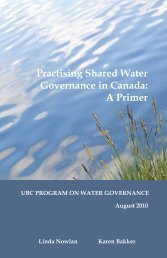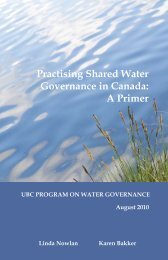Water Security Status Indicators - Program on Water Governance
Water Security Status Indicators - Program on Water Governance
Water Security Status Indicators - Program on Water Governance
You also want an ePaper? Increase the reach of your titles
YUMPU automatically turns print PDFs into web optimized ePapers that Google loves.
WATER SECURITY GUIDANCE DOCUMENT<br />
PART 2 SECTION 4<br />
WATER SECURITY STATUS INDICATORS (WSSI)<br />
• WSSI <str<strong>on</strong>g>Indicators</str<strong>on</strong>g> should be easy to understand, timely, relevant, reliable,<br />
c<strong>on</strong>sistent, credible, transparent and accurate.<br />
• WSSI indicators should be comprehensive, integrative and accessible.<br />
• C<strong>on</strong>sider the water source (groundwater, surface water, or integrated),<br />
and whether the choice of WSSI indicators reflects this.<br />
• C<strong>on</strong>sider land use activities and intensity, which may impact water quality<br />
and quantity.<br />
• A number of agencies develop indicators for multiple scales (internati<strong>on</strong>al,<br />
nati<strong>on</strong>al, regi<strong>on</strong>al, provincial and local). C<strong>on</strong>sider how accessible relevant,<br />
existing indicators are (e.g., will the developer share the index formula or<br />
calculator?), and whether the indicators can be adapted to suit your needs.<br />
• Once the variables (i.e. parameters) to be assessed have been selected, the<br />
standards against which they are to be compared also need to be chosen<br />
(local, provincial, pan-Canadian, or internati<strong>on</strong>al).<br />
• There are overlaps between water quality and quantity in terms of aquatic<br />
ecosystem health and human health. Some indicators can be applied to<br />
more than <strong>on</strong>e category. For example the Canadian Council of Ministers<br />
of the Envir<strong>on</strong>ment (CCME) <str<strong>on</strong>g>Water</str<strong>on</strong>g> Quality Index (WQI) http://www.<br />
ccme.ca/ourwork/water.html?category_id=102 (refer to Example of Assessment<br />
Method) can be used as an indicator for both human health and<br />
aquatic ecosystem health, if different parameters and objectives are applied<br />
(CCME 2001).<br />
• Understanding the scale for which an indicator was developed is an important<br />
c<strong>on</strong>siderati<strong>on</strong>. Is the indicator of choice sensitive enough (will it<br />
yield meaningful results) to be used at the scale identified for the assessment?<br />
(See Example of Assessment Method for an example of scalar challenges).<br />
• <str<strong>on</strong>g>Indicators</str<strong>on</strong>g> that incorporate ec<strong>on</strong>omic valuati<strong>on</strong> are emerging. Assess<br />
whether it is feasible to include ec<strong>on</strong>omic c<strong>on</strong>siderati<strong>on</strong>s in the assessment<br />
method.<br />
Box 1: C<strong>on</strong>siderati<strong>on</strong>s when selecting water quality indicators (in relati<strong>on</strong><br />
to aquatic ecosystem and human health)<br />
• Scale: There are internati<strong>on</strong>al (e.g., World Health Organisati<strong>on</strong>), nati<strong>on</strong>al<br />
(e.g., CCME or Health Canada) and provincial guidelines for<br />
drinking water quality. Parameters and standards vary accordingly.<br />
• Flexibility and Adaptability: The CCME <str<strong>on</strong>g>Water</str<strong>on</strong>g> Quality Index (CCME<br />
2001) http://www.ccme.ca/ourwork/water.html?category_id=102 is the<br />
<strong>on</strong>ly index to be accepted by all Canadian provinces and territories<br />
and adopted nati<strong>on</strong>ally, as it is flexible and adaptable.<br />
10







